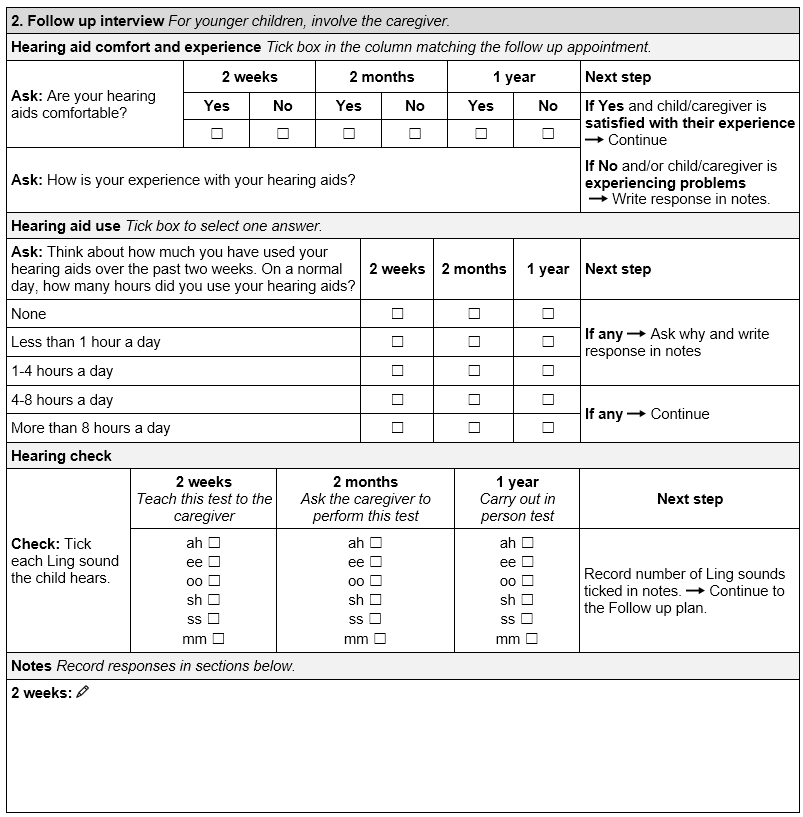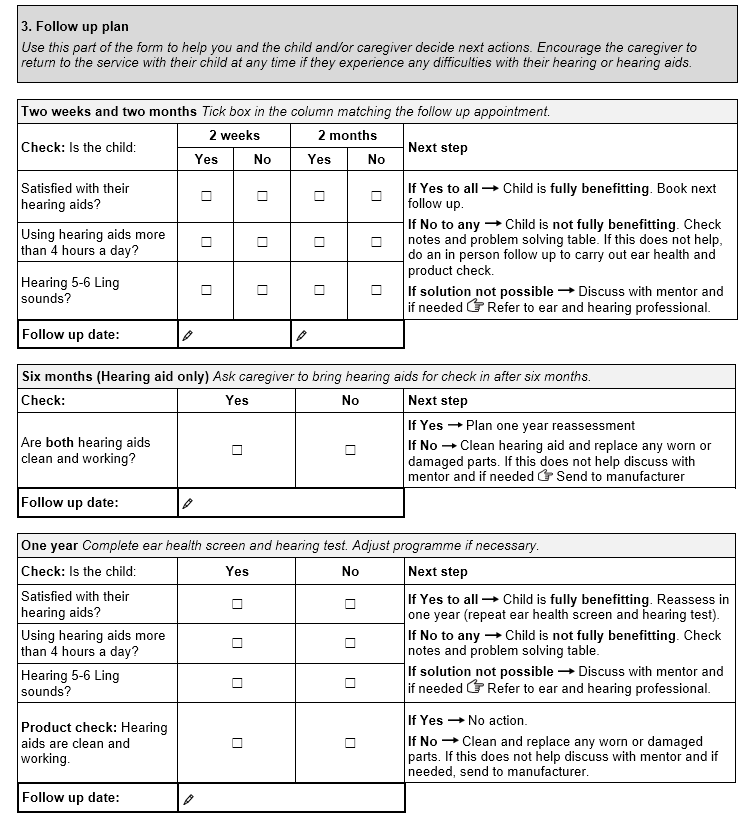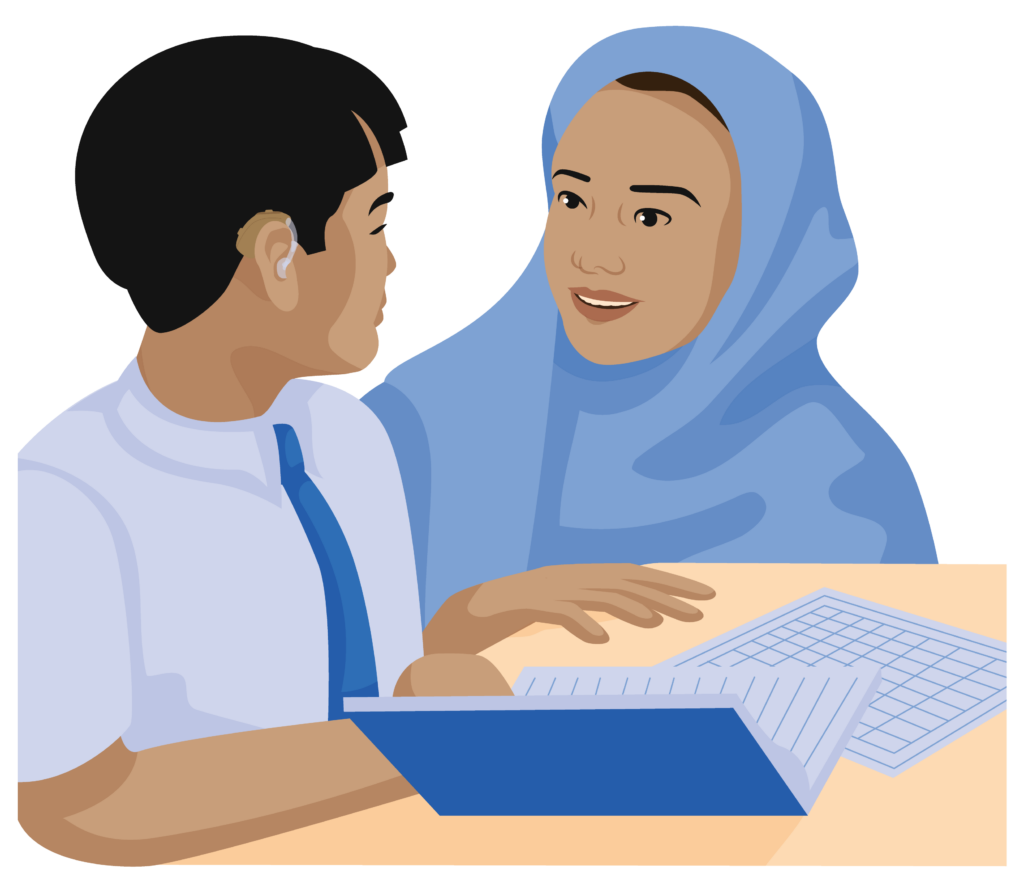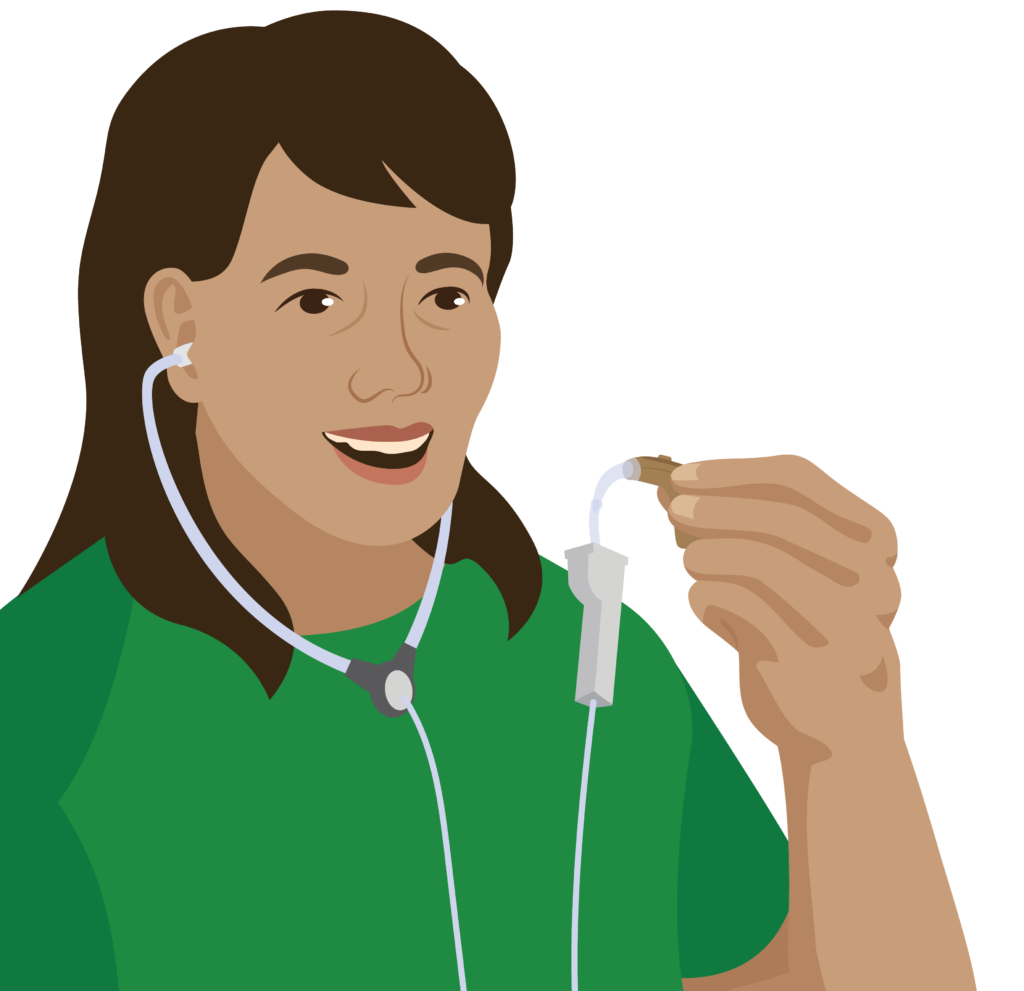Instruction
In this topic you will learn how to complete hearing aid follow up for children.
If you haven’t already, download the TAP Hearing aids follow up form for children and print a copy.
When to follow up
Early follow up is advised at two weeks and two months to support a child to adjust to their programmable hearing aids and gain maximum benefit. Children must be reassessed every year.
Follow up location
Follow up may take place:
- Remotely by phone or video call; or
- In person.
In person follow up
Generally, the decision on remote or in person follow up is based on what is most suitable for the child’s situation. However, some follow up appointments must be done in person.
For a child this includes:
- The first follow up appointment
- Yearly reassessment appointments.
Why do follow up?
Follow up for hearing aids will help you find out if the:
- Hearing aids are meeting the child’s needs
- Hearing aids need repair or replacing
- Hearing aids still fit well
- Child needs any problem solving for safe and correct use.
Follow up for children
In this module, follow up for children includes children between 5-17 years old.
Children under five years old should be referred for assessment and follow up by an ear and hearing professional.
Information about the child
Instruction
Start by collecting general information about the child and record contact details for their caregiver.
Follow up interview

The same follow up form is used for the appointment at:
- Two weeks
- Two months
- Six months
- One year.
Instruction
Tick the box in the column matching the follow up appointment.
Children’s needs may change more quickly than adults as they are still growing. Reassessment each year is recommended.
It is important to check a child is fully benefitting from their hearing aids to support their learning and social activities.
Benefit from using hearing aids
There are three checks to see if a child is fully benefitting from using hearing aids:
- Hearing aid comfort and experience
- Hearing aid use
- Hearing check.
1. Hearing aid comfort and experience
Include the child and their caregiver.
Ask questions to find out if the child is satisfied with the comfort and experience of using hearing aids.
Instruction
Ask:
- Are your hearing aids comfortable?
- How is your experience with your hearing aids?
- If the child confirms their hearing aids are comfortable and the child and caregiver are satisfied with the experience Continue.
- If the child or caregiver answers no or the child is experiencing any problems Write response in notes.
2. Hearing aid use
Instruction
Ask: Think about how much you have used your hearing aids over the past two weeks. On a normal day, how many hours did you use your hearing aids?
- If the child is usually using their hearing aids for less than four hours a day, they are not benefitting enough from their hearing aids Ask why and write response in notes.
- If the child is usually using their hearing aids for four hours or more Continue.
3. Hearing check
The first follow up appointment is in person.
It is important to teach the Ling sounds test to the caregiver so it can be used at home to check how well their child’s hearing aids are working.
Show them the sounds and practise together before carrying out the test with their child.
Instruction
Advise the caregiver to do a daily listening check after putting the hearing aids on the child each day.

For a child to benefit they should hear 5 to 6 Ling sounds. Tick each Ling sound the child hears.
Record the number of Ling sounds ticked in the Notes section and Continue to the Follow up plan.
Follow up plan

Use this part of the form to help you, the child and their caregiver decide next actions.
Use the answers from the interview to inform the follow up plan.
Always encourage the caregiver to return to the service at any time if their child experiences any difficulties with their hearing or hearing aids.
Two week and two month follow up
Start by reviewing the answers to the questions to see if a child or their caregiver are experiencing any problems.
A child is fully benefitting from their hearing aids if they:
- Are satisfied with their hearing aids comfort and experience
- Use their hearing aids more than four hours a day
- Can hear 5-6 Ling sounds.
Instruction
- If yes to all Child is fully benefitting. Book next follow up.
- If no to any Child is not fully benefitting. Check notes and carry out problem solving. If this does not help, do an in person follow up to carry out ear health and product check.
- If solution is not possible Discuss with mentor and if needed Refer to ear and hearing professional.
Remember Basir?

Basir is a schoolboy who has been fitted with programmable hearing aids.
Basir attends a two week follow up appointment with his father. Basir is using his hearing aids for two hours a day.
The health worker asks questions to find out why. Basir explains he is not used to wearing hearing aids and takes them out when playing with his friends.
The health worker explains it will be easier to play with his friends if he wears his hearing aids and encourages him to wear them more each day.
They plan a follow up call in two weeks to see how he is getting on.
Six month follow up – hearing aids only
Children may cause extra wear and tear on hearing aids. Regular checks of their hearing aids are advised.
Ask the caregiver to bring the hearing aids to the service for a check at six months.
Remind them to bring them in the hearing aid box to protect the hearing aids while being transported.
Product check
Using a listening tube confirm each hearing aid is working. You should:
- Clean and check each hearing aid
- Replace any worn or damaged parts. If necessary, check the problem solving table. If this does not help discuss with mentor. If needed, send hearing aid to manufacturer
- Plan one year reassessment.

One year follow up
This appointment is a reassessment. It should be in person.
You will need a screen form, the child’s original assessment form and a follow up form.
It is also important to check each hearing aid is clean and working.
Instruction
Complete new:
- Ear health screen
- Hearing test.
Adjust hearing aid settings if hearing test results have changed.
Instruction
Refer to the TAP Hearing assistive products module for more information on ear health checks.
One year follow up plan
Continue to ask questions to check how the child is benefitting from their hearing aids including:
- Hearing aid comfort and experience
- Hearing aid use
- Hearing check.
Instruction
- If yes to all Child is fully benefitting. Reassess in one year (repeat ear health screen and hearing test).
- If no to any Child is not fully benefitting. Check notes and problem solving table.
- If solution is not possible Discuss with mentor and if needed Refer to ear and hearing professional.
Question
What should you do if the results of a child’s hearing test have changed significantly. For example, more than one grade of hearing loss?
Select one.
Discuss with your mentor is correct!
If a child has had a significant change in hearing in one or both ears, always discuss with your mentor and if necessary refer to an ear and hearing professional.
Product check
Carry out hearing aid check using the listening tube.
Clean and check each hearing aid. Replace any worn or damaged parts.
If the child or caregiver describe any problems with how the hearing aids are working, check the problem solving table.
Question
What do you need to complete a product check?
Select and click to check answers.
Correct!
It is important to check and clean all parts of the hearing aid.
Correct!
Spare parts such as ear hook, earmould, earmould tubes and batteries commonly need replacing.
Incorrect.
This is used when checking how well a child can hear with their hearing aids.
Remember Basir?

Basir is a six year old schoolboy. He uses programmable hearing aids.
He has returned to the service with his parents for a one year reassessment. He is finding it easier to learn at school. Basir and his parents are happy with the hearing aids.
The health worker carries out an ear health screen. Basir’s ears are healthy.
The health worker repeats his hearing test. The test result has changed a little. Adjustments are made to Basir’s hearing aid settings. His hearing aids are working well.
The health worker asks Basir’s parents to return with Basir for reassessment in one year or return sooner if he experiences any difficulties with his hearing or hearing aids.
Maintenance, repairs and problem solving
Maintenance, repairs and problem solving are an important part of follow up.
Encourage caregiver to return to the service with their child at any time if they experience any difficulties with their hearing or hearing aid.
Instruction
Refer to the TAP Preprogrammed hearing aids module for more information on maintenance, repairs and problem solving.